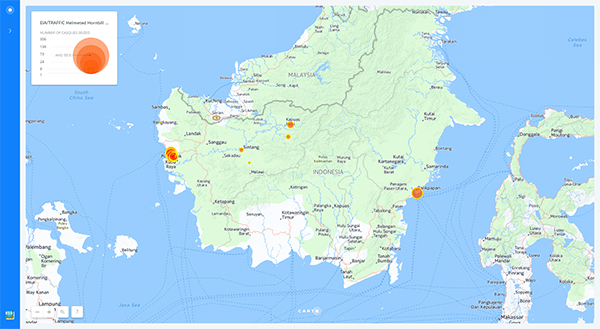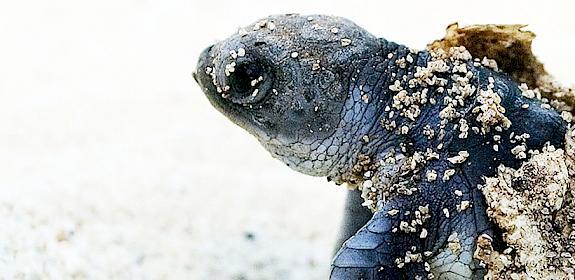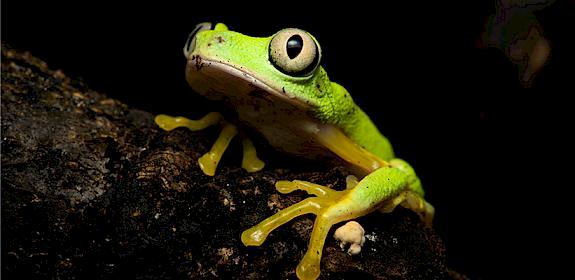Mapping seizures to aid conservation of imperilled Helmeted Hornbill
Kuching, Malaysia, 16th May 2017—An updated trade hotspot map by the Environmental Investigation Agency (EIA), and TRAFFIC reinforces the position of China and Indonesia as the world’s most important countries involved in the illegal trade in Helmeted Hornbill Rhinoplax vigil parts and products.
The Helmeted Hornbill is a large rainforest bird found in Southeast Asia which, unique among the hornbills, has a solid bill casque, a helmet-like structure on the bill that is made of solid keratin that is highly prized as an ivory alternative to be carved into luxury decorations and jewellery.
This has driven trade to critical levels, such that the Helmeted Hornbill was uplisted in 2015 by the International Union for Conservation of Nature (IUCN) from Near Threatened to Critically Endangered in the space of three years.
Analysis shows at least 2878 Helmeted Hornbill casques, skulls and products were seized from at least 59 known confiscations from 2010 to 2017.
It points to high poaching levels in Indonesian Borneo, with the Supadio and Sepinggan Aiports in West and East Kalimantan respectively being the most reported locations of seizures in Kalimantan.

The Soekarno-Hatta International Airport in Jakarta is Indonesia’s major international exit point for trafficked wildlife, including species from Kalimantan, such as the Earless Monitor Lanthanotus borneensis.
Shenzhen and Hong Kong stand out as the most important ports connecting hornbill part shipments from Indonesia to mainland China. Vigilance at these bottleneck exit and entry points is crucial to intercept illegal shipments.
High numbers of seizures were also recorded in Fujian province, in particular Putian and Xianyou, where there is a traditional hornbill casque carving industry.
“These confiscations signify good efforts by authorities in each country, but they cannot do it alone. The organized criminal networks behind this trade, who are moving hundreds if not thousands of parts per shipment, must be dismantled by focusing on key pressure points along the trade chain,” said Dr Chris R Shepherd, TRAFFIC’s Regional Director for Southeast Asia.
TRAFFIC is presenting an update on the trade situation, including a new analysis of global seizures, observations of Helmeted Hornbill parts for sale in Lao PDR, and observations from ongoing e-commerce monitoring from China, at the International Hornbill Conference 2017.
Immediately after the conference, government officials and researchers working on Helmeted Hornbills are convening at a two-day workshop to develop an action plan for the species.
Urgent priorities to be discussed include increasing in situ habitat protection against poaching, concerted enforcement action at known smuggling hotspots, and demand reduction in consumer countries.
“Markets selling Helmeted Hornbill products openly, such as those in Lao PDR, which cater to a largely Chinese clientele, must be shut down. Otherwise, law enforcement agencies will constantly have to battle against the open supply that undermines all international rules and law enforcement effort,” said Kanitha Krishnasamy, TRAFFIC’s Senior Programme Manager, who carried out the Lao PDR research. “Investigations need to target the traders that are operating with impunity too.”
“We call on the Government of China to conduct targeted intelligence-led investigations of carving operations within renowned areas historically associated with the ivory and rosewood carving industry. As highlighted by this map, key nodes include Xianyou and Putian in Fujian Province, where the processing and carving of Helmeted Hornbill casques and other endangered species takes place,” said Matthew Lowton, EIA’s Wildlife Campaigner.
EIA had previously published the seizures map for the 17th meeting of the Conference of the Parties to the Convention on International Trade in Endangered Species of Wild Fauna and Flora (CITES COP17) in September last year.
Notes:
The Environmental Investigation Agency (EIA) is a UK- and Washington DC-based Non-Governmental Organisation that investigates and campaigns against a wide range of environmental crimes, including illegal wildlife trade, illegal logging, hazardous waste and trade in climate- and ozone-altering chemicals.
Contact: Matthew Lowton, Wildlife Campaigner, +44 (0) 207 3547960,
TRAFFIC, the wildlife trade monitoring network, is the leading non-governmental organization working globally on trade in wild animals and plants in the context of both biodiversity conservation and sustainable development.
The Convention on International Trade in Endangered Species of Wild Fauna and Flora (CITES) is an international agreement to which governments voluntarily adhere and which seeks to ensure that the trade in specimens of wild animals and plants does not threaten their survival




